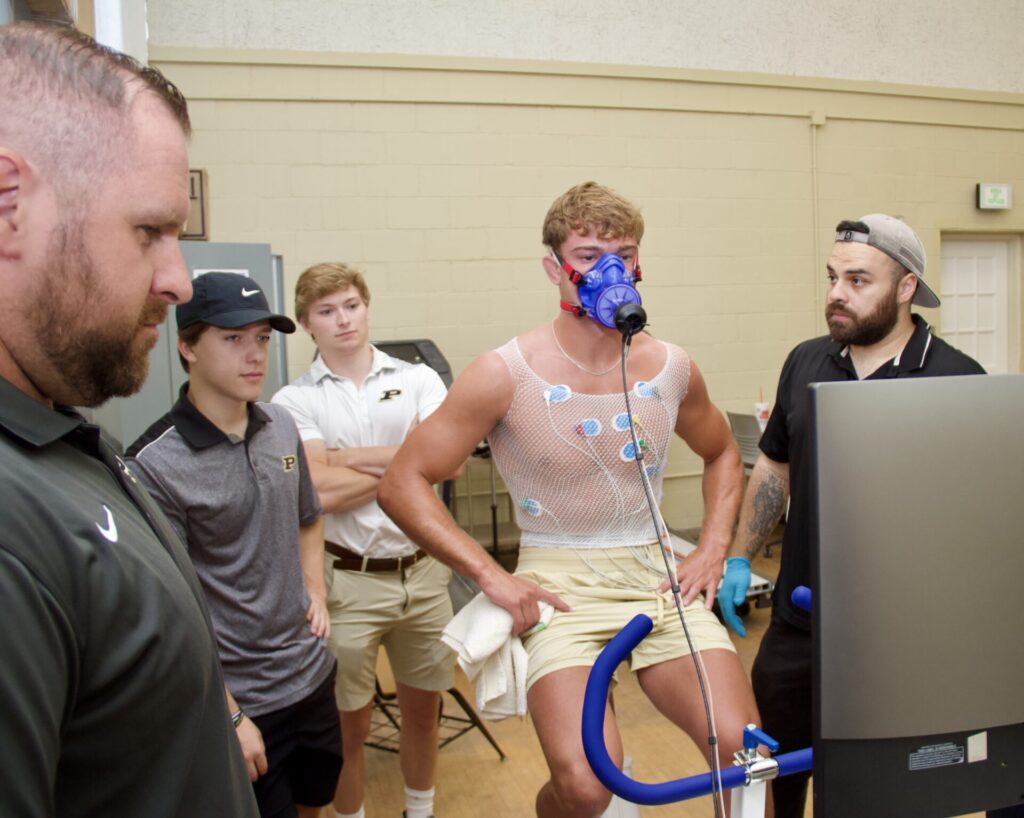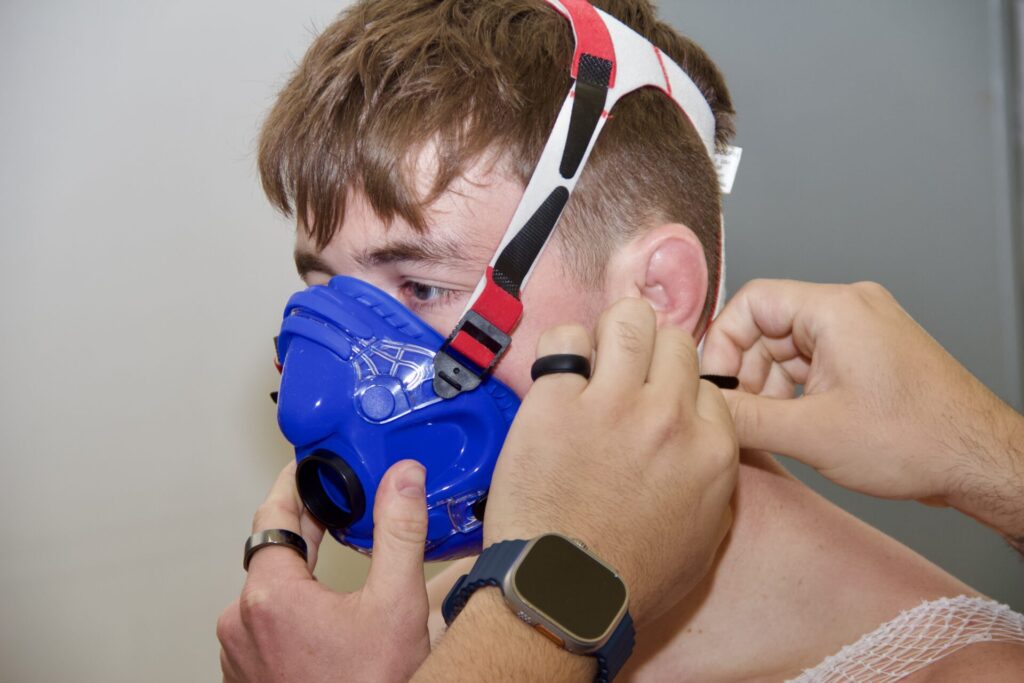Purdue Health and Kinesiology faculty, students cradle data to enhance Purdue wrestlers’ performance

Purdue University wrestler James Rowley, left, pumps the pedals on a stationary bike during a VO2 max test. Ivan Alonso, middle and a graduate student in the Department of Health and Kinesiology, checks blood pressure while Cassandra Ledman, clinical associate professor, checks the test’s real time data. Tim Brouk
Written by: Tim Brouk, tbrouk@purdue.edu
When it comes to NCAA wrestling, BIG 10 programs have a firm headlock on the sport. At the end of the 2023-24 season, half of the top 14 schools were from Purdue University’s athletic conference.
With so much competition for one of the most rigorous sports a student-athlete could compete in, coaches are looking for any possible improvement to gain an advantage for a victorious bout.
Over the summer, faculty and students from the Purdue Department of Health and Kinesiology (HK) conducted metabolic testing for 11 Purdue wrestlers in collaboration with the team’s strength and conditioning coach and team dietitian. The tests — VO2 max testing and resting metabolic rate — work in concert with the athlete’s exercise and eating plans.
“We want to give them the best opportunity to compete in the toughest conference in the country against the toughest competition. We want them to excel,” said Jason Pullara, Purdue Athletics director of strength and conditioning. “So, for us to have this level of detail, combined with our processes and our training models, gives us a really great opportunity to give them a chance to have success at a sport they love to do.”
Jason Chrapek, Health and Kinesiology clinical assistant professor and director of the A.H. Ismail Center for Preventive and Lifestyle Medicine, was thrilled to collaborate with Purdue Athletics for the testing. It gave his colleagues and students hands-on experience in conducting the tests while helping student-athletes potentially compete at a higher level.
“It’s really a team effort on getting them to be the best possible athlete. A 1% difference in performance at this level could be the difference between winning and losing. We’re looking for that little bit of competitive edge, and we do that through accurate testing,” Chrapek explained. “The things we’ve talked about in the department are building more of a relationship with athletics to not only do testing for them and help them do their jobs better but also give our students hands-on experiences. In our field, you will learn 10 times as much actually doing the job as you will from the textbooks you will read in class.”
Ethan Fullenkamp, a senior studying kinesiology, assisted Chrapek with VO2 max and resting metabolic rate tests. Getting this experience over the summer should ensure a strong final year as a Boilermaker undergraduate while he connects lessons learned in the classroom to real-life testing.
“The first thing I noticed is that I’ve done almost the exact tests in class, and I was able to apply what I learned in class into real-world scenarios to where we get data to help (Purdue) Athletics,” Fullenkamp said. “Both of these tests go hand-in-hand.”
VO2 max


The wrestlers were fitted with a mask that was connected to a metabolic cart, which measured the athletes’ expired air by looking at the concentration of oxygen and carbon dioxide of each breath. By comparing the expired air to a sample of room air, they were able to analyze how much oxygen the body was using at that intensity. The testing was also able to find what fuel source — carbohydrates or fats — the athlete is primarily utilizing. Data on fuel utilization, as well as aerobic and anaerobic threshold estimates, give the strength staff and team dietitians valuable information that will help them adjust training and nutritional approach for each individual wrestler.
A dozen leads attached to sensors were applied to the athletes’ chests, held in place by a mesh body vest, to collect aerobic capacity data via electrocardiogram, giving 12 “views” of the student-athletes’ hearts. On the bike, resistance was built up every two minutes while graduate student Ivan Alonso checked blood pressure, also every two minutes. The goal was to get the wrestler to maximum heart rate.
Cassandra Ledman, clinical associate professor of health and kinesiology, recorded data during the test and checked in with the wrestlers as they pedaled. Since the ventilator covered their mouths, the athletes had to point at the level of exertion they are feeling from six, the lowest and most comfortable, to 20, the highest and most difficult.
Resting metabolic rate



While VO2 had the wrestlers peddling hard, the only challenge they had for the resting metabolic rate test was to not fall asleep. The test required the athletes to be rested but conscious to gather their oxygen intake and respiratory quotient, which tells Chrapek and his team what fuel source (carbohydrates or fats) that individual athlete’s body prefers to run on at rest. In a weight class-based sport, this gives insights that will help the team dietitian individually tailor nutritional approaches to help limit any detrimental effects on performance while the athlete works to cut down to their weight class.
Resting metabolic rate tests had another ventilator attached to the wrestler and a computer, but the athlete was in a prone position in a darkened room within the Ismail Center. This test discovered the baseline of caloric burn for each athlete while they rested. The analysis informed the diet for each athlete.
“We can equate that out to how many calories they’re burning throughout the day,” Chrapek said. “The dietitian can then use that data to really dial in how many calories they need to eat based on what phase they’re in. Managing that without being detrimental to performance is the key to being as successful as possible.”
Junior wrestler Ben Vanadia shared what he eats during the season: For breakfast, it’s two eggs, a bagel, cream cheese, bacon, cheese and mayonnaise. Lunch is usually something simple and on-the-go like a Subway sandwich. Dinner is rice, steak and broccoli. At the 197-pound weight class, Vanadia is eager to use the tests to gain an edge on his opponents next season.
“We’ve definitely taken more of a smarter approach to our training, more of an in-depth look,” Vanadia said. “We’re really trying to focus in and dial in on the scientific and little ways we can get better and be ahead of our competition. Nutrition’s probably the biggest thing in wrestling because if you don’t fuel your body, you’re not going to output what you want to output. The RMR (resting metabolic rate) test gives us a body composition and what we can eat at our metabolic rate.”
Pullara welcomed the collaboration with HK and found it to be a valuable resource for his athletes.
“We want to be as detailed as possible with our training, individualized as possible,” Pullara said. “So having this extra level of detail, to have a our cardiorespiratory with aerobic capacity, gives us an opportunity to use some of our other tools like heart rate monitors to be very specific with what we are trying to achieve with each individual in how we train them to maximize their potential and hopefully their overall performance on the mat.”
For any questions about metabolic testing for yourself or your athletes, please reach out to Chrapek at jchrapek@purdue.edu.
Discover more from News | College of Health and Human Sciences
Subscribe to get the latest posts sent to your email.